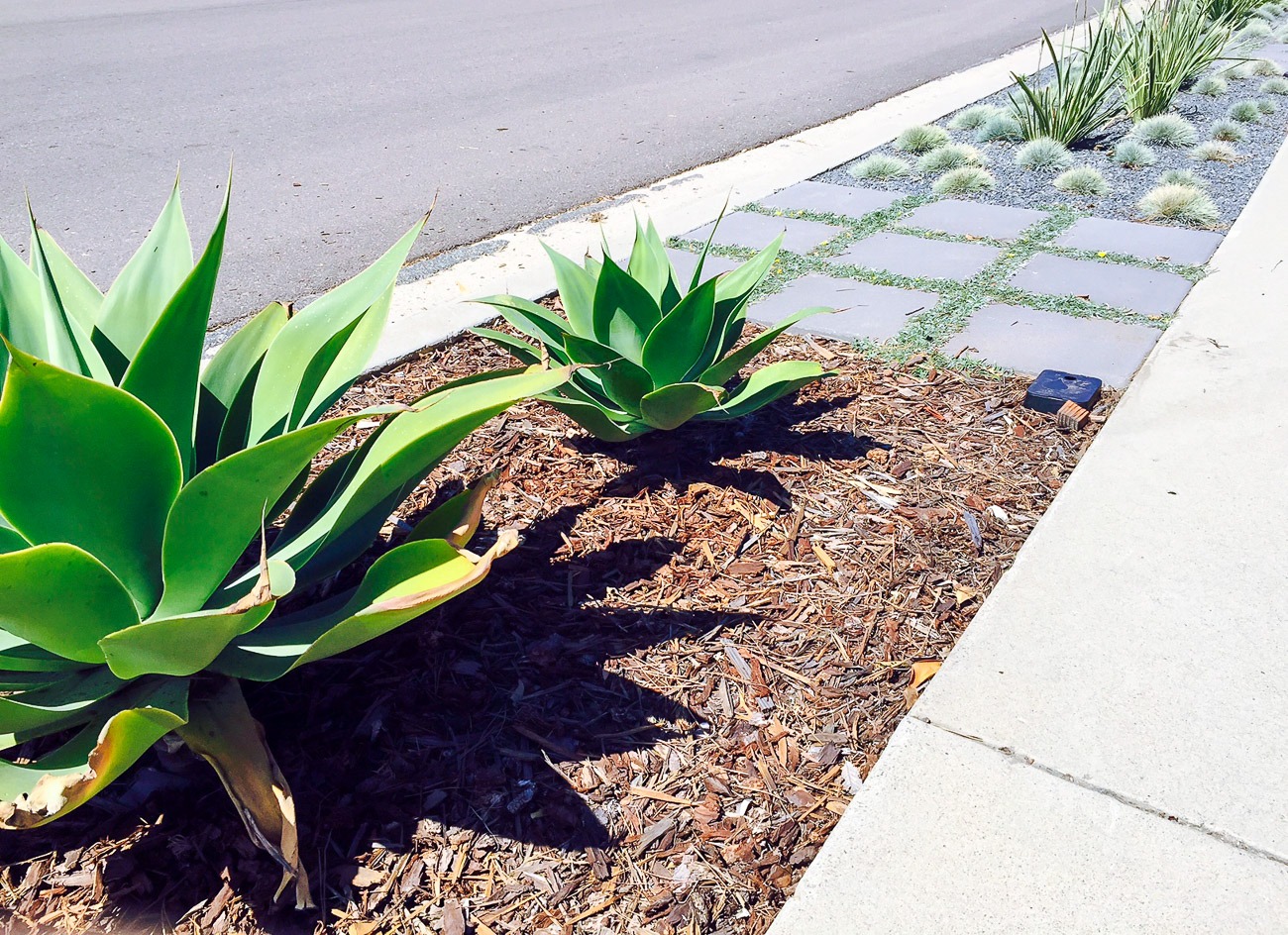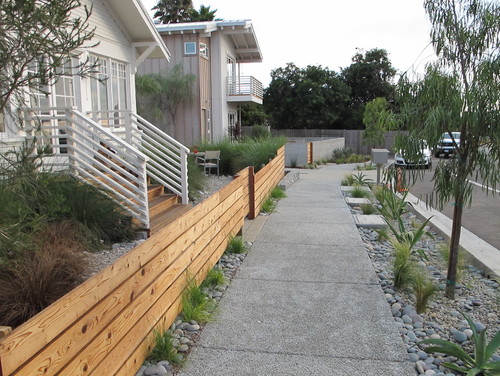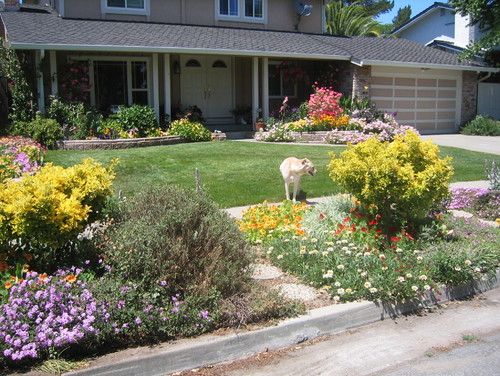How to Landscape a Parking Strip Without Real Grass

What do you call that patch of grass between the street and the sidewalk? It’s a parking strip and one of the first things guests may see when pulling up to your house. The most common landscaping strategy used to involve filling the area with grass, but as the California drought continues, many homeowners are swapping out this grass for water-wise alternatives as a first step to going completely lawn-free. Other names for a parking strip include parkway strip, hellstrip, tree lawn and planting strip.
Parking Strip Challenges
Because parking strips are thin rectangles, they are notoriously difficult to irrigate even with microspray spinklers. An abundance of wasteful overspray usually hits the street, wasting money as well as a precious resource.
Your parking strip design needs to withstand foot traffic and damage from dogs walking by. It usually isn’t the best quality soil either because it may absorb construction, street and dog waste. Not to mention the soil is usually extremely compact due to initial street and home construction. In addition to potentially receiving full sun, at least in Southern California, reflective heat from the black asphalt adds to the already harsh conditions.
City and Utility Concerns
Because of proximity to the sidewalk, you’ll need to check local regulations to determine which trees are considered acceptable. The City of San Diego maintains a list of acceptable street trees, however, you may use one not listed with written permission. Also check to see if your neighborhood has any specific rules like tree height restrictions. Check your city ordinance to be sure that you actually own that piece of land and what your maintenance requirements are. Are there permits necessary? You’d better find out. Also, if your home is a part of a homeowners association or subject to approval by a neighborhood architectural committee, this will greatly impact what you might be allowed to do.
Underneath virtually every parking strip are power lines to your house, sewer and water pipes, irrigation pipes, phone lines and more that would be potentially dangerous or inconvenient if disrupted. Consider whether or not if would be costly to dig into your new parking strip design. For example, if the city is upgrading your street’s electrical system they can dig into this area and any repairs will be at your cost. In San Diego, call 511 before digging anywhere in a parking strip (or elsewhere on your property). They will come out and mark your utility lines at no cost.
Parking Strips Can Be an Asset
Small lots are common in coastal Southern California so maximizing a parking strip’s growing space is a great way to extend your garden and tie together your home’s decorative features. It isn’t unheard of for people to integrate edibles into this space (keep in mind pedestrian traffic and dogs) or use plants that yield cut flowers to brighten up your home.
Safety Concerns
Parking strip plant selection is incredibly important because they must not impede the flow of pedestrian traffic in any way. Plants also shouldn’t be sharp or poisonous to dogs, kids or adults. Clear access from the street to the home must be granted without tripping hazards. In fact, access points are probably the first aspects you’ll need to decide on any parking strip plan. The plants need to be placed and maintained in such a manner that cars are able to park safely.
Street Tree Guidelines for City of San Diego
The City of San Diego actually encourages tree plantings in parking strips as a means to filter storm runoff, contribute energy savings via shade and because they can enhance property value when selected correctly. While native trees are preferred, certain palm trees are allowed. Pygmy date palms are a popular choice but remember they have thorns, can grow a bit slanted, and aren’t quite tall enough for pedestrians to walk under the fronds. Be mindful that certain trees grow strong, wide roots that can buckle sidewalks and cause other headaches over time. If you are planting trees near the street, you’ll need to fill out an application for a no-fee street tree planting permit.
Parking Strip Design Tips
Because the area is so narrow and wide, planting fewer species in drifts helps maintain a simple, classic look. Scale is also important as too many plants can yield a cluttered look. Too big not only looks out of place, but has the potential to be a security hazard if your front yard is open to the street and not gated.
A good rule of thumb is that there should be one access point through your parking strip at every car length. Consider how guests will step on to the access point. Will irrigation puddle in the area? Will they track mud into your house if it rains? Drainage is key.
What Locals Are Doing
As mentioned previously, there is a big movement in San Diego to replace lawn parking strips with water-wise alternatives. This is also likely due to the existence of rebates for replacing existing lawns. Here are some ideas that we’ve spotted lately. Replace parking strip grass with artificial grass. While it is completely fine to lay it across the entire parking strip remember that it can surround trees and be used as strips of grass in between pavers. Surrounding the base of trees with water-wise and other plantings liven up parking strips. Or, use this area to rotate seasonal color in and out of the garden.
Decorative rock is an extremely popular choice in our coastal neighborhood.
Some homeowners use only rock while other space agave, ornamental grasses or aeonium rosettes in between. If it sounds boring, it actually fits particularly well in contemporary home design, as you can see above. A very inexpensive option involves surrounding sporadically-placed plants with simple mulch, but this strategy can either look awesome or cheap.
Your Turn…
Getting rid of parking strip grass is the first step for homeowners who aren’t comfortable ditching all grass in one go. How did you landscape yours?




